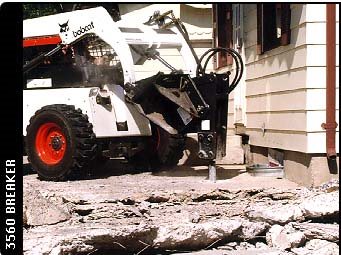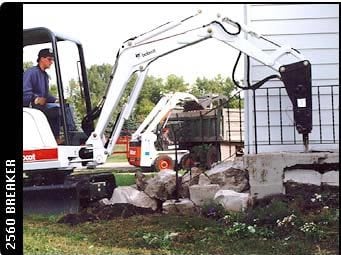- Concrete Demolition Home
- Concrete Breaking Tools
- What to Do with Demolished Concrete
- Concrete Recycling
- Urbanite: Repurposing Old Concrete
- Fixing Concrete
- Concrete Repair
- Concrete Resurfacing
Concrete Demolition Methods & Equipment
When removal and replacement of existing concrete is your best option, use this guide to learn more about permit requirements, the different methods of demolition and how to save money by recyclingThe following is for GENERAL INFORMATIONAL USE ONLY. This is a very general overview of the permitting process for demolition projects. The actual process may vary widely between regions of the country, counties and municipalities.
You’ll also find an overview of common demolition methods and tools. Compare your options for how to demolish existing concrete as well as what equipment to use. Furthermore, you’ll be able to find safety information and warnings about possible hazards during demolition.
Jump ahead to your topic of interest:
- Conditions calling for removal and replacement
- Concrete demolition methods
- Permit requirements for concrete demolition
- Avoiding hazards during concrete removal
CONDITIONS CALLING FOR CONCRETE REMOVAL AND REPLACEMENT
There are certain conditions under which using a patching compound and resurfacing product will result in merely a short-term fix. Under these conditions, patching the concrete prior to resurfacing or doing a decorative topping would be a waste of time and money, as the surface or topping would soon display the same characteristics as the concrete you tried to repair.
These conditions include:
- Deep, widespread cracks where settlement has occurred. This may be due the weight of large trucks, improper preparation of sub grade, erosion of sub grade, or for other reasons.
- Concrete slabs that have sunk, which may occur when the sub grade was not prepared properly. Loose dirt may have been used for the sub grade. When this dirt settles-sometimes due to sprinkler or rainwater going under the concrete- the concrete is unsupported and will be more susceptible to sinking. It is also possible that the sub grade was compacted and the concrete was subjected to extreme weight, which caused the concrete to sink.
- Concrete slabs that show obvious signs of frost heave. Frost heave is very common in cold climates. Moisture in the ground freezes and the concrete pushes upward.
- Concrete slabs that have so much spalling or pitting on the surface that is it more economical to replace the concrete rather than prepare the entire surface for resurfacing and resurfacing the concrete.
Under any of the above conditions it will be better to remove and replace the concrete.
Find local concrete contractors that can tear out your old concrete and replace it with beautiful new decorative concrete.
There are a myriad of other reasons why concrete will need to be removed on a project:
- Addition to a commercial or residential building requires removing concrete that is in the way of the addition.
- The entire structure is being removed of which the concrete is a part of the structure.
- There is faulty concrete construction which the owner wants torn out and replaced.
- Old curbing is to be removed for street improvements, road widening, etc.
CONCRETE DEMOLITION METHODS
Pressure Bursting
Pressure bursting can be used in cases where relatively quiet, dust-free, controlled demolition is preferred.
Both mechanical and chemical pressure bursting split the concrete, either with a splitting machine operating on hydraulic pressure provided by a motor in the case of mechanical bursting, or through the insertion of an expansive slurry into a pre-determined pattern of boreholes in the case of chemical bursting.
The split concrete is then easily removed, either by hand or by crane.
Hydraulic and chemical pressure bursting break up concrete structures with a minimum of noise and flying debris. Both methods work by applying lateral forces against the inside of holes drilled into the concrete, and can do virtually any job other demolition methods are capable of. However, rather than shattering the concrete into bits as dynamite and impact tools would, the lateral forces build up over time to crack the concrete into smaller sections.
Mechanical bursting highlights
- Inexpensive, quiet, no vibration
- Initial drilling of holes for splitter does produce some noise and vibration
- Diamond-tipped coring machine greatly reduces noise and vibration during hole drilling, but is much more expensive
- Controlling crack direction and movement of demolished concrete can be difficult
- Hand-held or machine-mounted breaker may be needed to expose reinforcing bars for cutting
Chemical bursting highlights
- More costly method of pressure bursting
- Can split concrete in a controlled manner
- In excess of 4300 psi of expansive pressure may be generated to produce concrete cracking within 10 to 20 hours
- Quiet, no vibration, little or no dust
- Temperature sensitive freezing greatly reduces effectiveness
Pneumatic and Hydraulic Breakers
Often used in concrete demolition projects involving bridge decks, foundations and pavement, hand-held or boom mounted pneumatic and hydraulic breakers are currently the toolof choice.
The amount of work accomplished using these methods depends on the hammer size, strength of the concrete, the amount of steel reinforcing used in the concrete, and working conditions.
Machine-mounted breakers are able to deliver a range of 100 to 20,000 foot-pounds at 300 to 800 blows per minute. Machine-mounted breakers may utilize:
- A telescoping boom for easy reach and maneuverability
- Remote control operation
- Underwater demolition capabilities
- Some limitations of machine-mounted breakers include the generation of noise, dust and vibration.
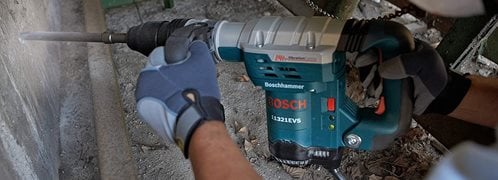 Bosch Chipping Hammer
Easily break vertical and overhead surfaces
Bosch Chipping Hammer
Easily break vertical and overhead surfaces
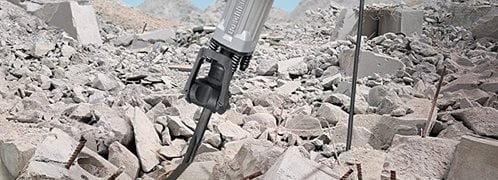 Demoltion Hammer from Bosch
Quickly and efficiently demolish concrete
Demoltion Hammer from Bosch
Quickly and efficiently demolish concrete
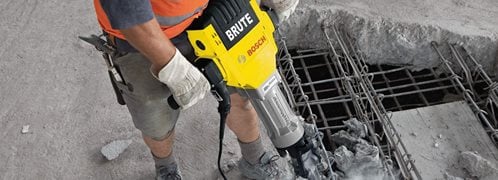 Bosch Pavement Breaker
Good for heavy-duty demolition jobs
Bosch Pavement Breaker
Good for heavy-duty demolition jobs
Dismantling
By cutting concrete elements, and then removing them by crane, the demolition of an entire concrete structure may be carried out with a minimum of noise, dust, and impact on surrounding structures.
This may be done by sawing, water-jetting or thermic lance, and is a particularly good method of demolishing portions of a structure, especially portions of walls or slabs.
Water-jetting
- Minimizes dust and eliminates dust and fire hazards
- Can be used to cut both straight lines and contours
- Requires the use of an abrasive and water-catching system during the cutting process
Thermic lance
- Excessive heat causes some deterioration of the concrete adjacent to the cutting
- Works particularly well in the presence of reinforcing steel
- Eliminates vibration and dust problems
- May create smoke and fire hazards
Ball and Crane for Demolishing Masonry and Concrete Structures
One of the oldest and most commonly used methods for building demolition, the ball and crane uses a wrecking ball weighing up to 13,500 pounds to demolish concrete and masonry structures. During the process, the ball is either dropped onto or swung into the structure that is to be demolished.
The ball and crane, however, is not suitable for all demolition applications. Some limitations:
While the concrete can be broken into rather small pieces, additional work in the form of cutting rebar may be necessary.
Only highly skilled and experienced crane operators should be used on ball and crane demolition projects -- smoothness in controlling the swing of the ball is important since missing the target may tip or overload the crane and a mild swing-back may cause the ball to hit the boom.
The size of the building that can be demolished with this method is limited by crane size and working room, including proximity to power lines.
This form of demolition creates a great deal of dust, vibration and noise.
Explosives
Explosives are generally used for removing large volumes of concrete via insertion of explosive devices in a series of boreholes:
- Versatile and flexible in terms of work output
- Vibration and air blast may damage surrounding structures
- Heightened safety considerations involved when compared to other demolition methods
PERMIT REQUIREMENTS FOR CONCRETE DEMOLITION
When is a demolition permit required?
Most governmental bodies require a permit to be pulled before the demolition of any structure, which may include stand-alone concrete structures such as sidewalks, seawalls, or other concrete walls. Permit forms may be available through the building department, an inspection services department, and sometimes through the municipal fire department if there is a structure abatement program in place.
Why are Demolition Permits Required?
Most often, the purpose of a demolition permit is to enable the governing body to monitor any works or activities performed within its jurisdiction for public safety monitoring. The permit also usually ensures that plans comply with various other concerns, such as environmental regulations and asbestos and other HazMat issues.
Who Can Apply for a Demolition Permit?
Usually this is determined by the type of work to be performed. For instance, a licensed general contractor may be allowed to obtain a permit to demolish any structure, while other licensed contractors may be restricted to the demolition of a structure that will be replaced, and to disassemble/re-assemble any building. Many states allow owners to apply for a demolition permit when the project involves an owner-occupied residence.
What Does the Demolition Permit Cost?
The cost of most demolition permits is relatively inexpensive between about $15 and $25.
However, there are often additional fees for services such as inspection of the electric power disconnection and for capping water and sewer at the property line.
An additional cost for an encroachment permit may be required in order to abandon the sewer at the main (this must be done by a licensed plumbing contractor, in most cases).
Additional municipal fees may be involved depending if the property is anticipated to be developed within a reasonable time (this involves have the water shut off at the property line) or if no development is anticipated (this involves the water service being abandoned at the main).
What is Involved in the Typical Demolition Permit Process?
The following procedure is a general guideline in terms of applying for a demolition permit:
You usually have to obtain some type of approved demolition release form from the appropriate state, county or municipal body prior to applying for a demolition permit.
The demolition release form must be completely filled out and submitted to that regulatory body which is directly responsible for demolition in your area. All fees must be paid at this time.
Contact appropriate utilities, including water, electric, and gas, as well as the telephone and cable companies to remove meters and wires.
If necessary, obtain approval from the appropriate municipal body to abandon water and/or sewer.
What is Involved in the Inspection Process?
You will usually need an inspection prior to demolition of the structure. Typically the city inspector verifies that all utilities and water and sewer facilities are disconnected. A final inspection is required after all demolition and final clean up has been completed.
AVOIDING HAZARDS DURING CONCRETE REMOVAL
Concrete Demolition Unknowns (job site surprises that shouldn't surprise a demolition contractor)
Most concrete contractors, even though not demolition specialists, will have to demolish portions of structures as a part of their usual business. Knowing which method or combination of methods to use for demolition of reinforced or prestressed concrete structures is essential for a safe and profitable job.
Demolition work involves many of the hazards associated with construction. However, demolition incurs additional hazards due to unknown factors such as:
- Deviations from the structure's design introduced during construction
- Approved or unapproved modifications that alter the original design
- Materials hidden within structural members
- Unknown strengths or weaknesses of construction materials used on the project.
Many concrete contractors specialize in jobs that include demolition. Some contractors only do demolition- and leave the concrete construction to other concrete contractors.
Concrete Demolition Safety Considerations
All personnel involved in a demolition project must be fully aware of the various hazards, which may be encountered, and the safety precautions that may be taken in order to control the hazards. Beginning any type of demolition project without all the players knowing every aspect of the plan is an invitation for something to go wrong.
Hold daily pre-job safety meetings with all workers, stressing safety basics, common sense, alertness, and proper use of demolition equipment. The meetings should cover inspection, proper use and maintenance of all tools and equipment.
Also, keep in mind that OSHA mandates an engineering survey be undertaken by a competent person prior to beginning a demolition project. This is necessary to determine the condition of overall structure, and also the possibility of the unplanned collapse of any portion of the structure. Safe floor loads should be determined to prevent overloading with demolition.
Hand Tool Hazards
The vast majority of hand tool injuries occur when the proper tool is not used for the job. Workers are often tempted to use whatever is at hand to hammer, pry or chip instead of going to get the proper tool. When the wrong tool is used for the job, injury is much more likely to occur than if the right tool is used correctly.
- Wrecking bars or crowbars:
- Make sure they have a sharp point or keen edge that allows the bar to get a firm hold on the object being moved. Using poor substitutes for these tools, such as pieces of pipe, angle, iron or other building materials can be a serious mistake, since the are more likely to slip or break and cause injury.
- Wire and bolt cutters:
- These require the wearing of eye protection at all times. Dont use a cutter too small for the task, or try to gain added leverage by putting a length of pipe over its handle. These tools are made to withstand a certain amount of stress, depending on their size. Dangerously over-stressing them can result in injury.
- Sledges and hammers:
- These also require workers to wear eye protection in order to prevent possible blindness from concrete chips and splinters. Inspect equipment prior to use for unacceptable conditions such as mushroomed heads, cracks, looseness and splinters.
- Shovels:
- Shovels are often thought of as a relatively safe construction tool, but improper use can cause serious back injuries, as well as injuries to other parts of the body. Proper use requires a firm, solid stance, and moving the entire body in the direction the material is being thrown instead of twisting the back or knees.
Machine-Mounted Tool Hazards
Falling debris is of particular concern in demolition projects, both in terms of the workers actually doing the demolition work, and other workers or bystanders. Make sure the demolition area is clear of all unnecessary personnel prior to work. Large attachments, such as those on excavators, require a viewing area of at least 75 feet, and one of about 30 feet for smaller attachments, such as those mounted on skid-steer loaders, backhoe loaders and mini-excavators. Make sure all attachments are installed according to the manufacturer's guidelines. Refrain from modifying tools or equipment without first contacting the manufacturer.
When an excavator, skid-steer loader, or other piece of equipment is used on a floor deck, floor openings must have protective curbs installed to prevent the equipment from falling through the opening.
Excavators should have cab safety screens installed over top and front glass when demolishing any type of overhead structure, as well as a falling objects protection structure (FOPS). Cab windows should be of transparent, shatterproof glass.
The ball on a ball and crane should not exceed the smaller of 50% of the crane's rated load capacity, or 25% of the breaking strength of the wire rope on which the ball is suspended. Check with the crane manufacturer before beginning work to determine if the crane can be used safely for demolition, as a demolition ball places unusual stresses on a crane boom.
Clothing and Dress Tips
A large part of demolition safety involves proper dress and the use of appropriate safety accessories, especially when using power tools.
- Do not wear loose clothing that can get caught in machinery
- Pull long hair back
- Remove any jewelry that can interfere with safe machinery operation
- Wear safety goggles or glasses with side protection
- Use a face mask in dusty applications, ear plugs when the site is especially noisy or for extended periods of work
- Heavy work gloves should be worn to protect against the steady vibration of power tools and the heat that can be generated, especially in the bit
- Wear steel-toed shoes or boots
